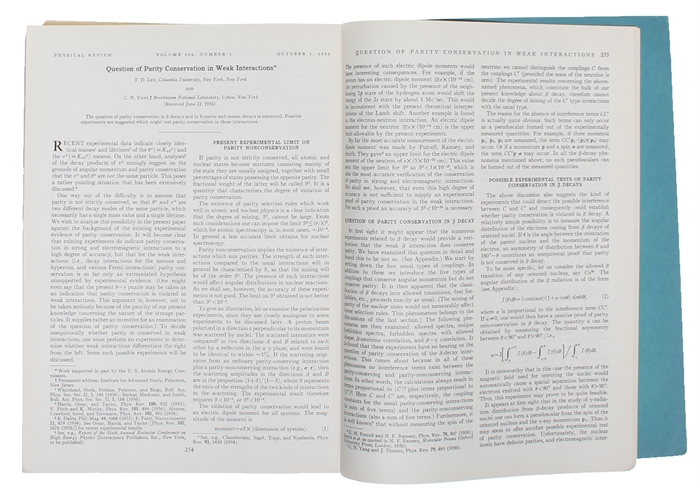FOUNDATIONAL THEORY OF THE UNIVERSAL FORCES OF NATURE
LEE, T.D. (+) C. N. YANG.
Question of Parity Conservation in Weak Interactions.
Lancaster, American Institute of Physics, 1956. Lex8vo. Volume 104, October 1, No. 1, 1956 of "The Physical Review", Second Series. Entire volume offered. In the original printed blue wrappers. Minor bumpings to extremities and two small tears to bottom and right side of front wrapper. Otherwise a fine and clean copy. Pp. 254-58. [Entire issue: (2), 272 pp.].
First printing of Yang and Lee's seminal and topic-creating paper which proved that parity is not conserved in weak interactions. "The discovery of parity nonconservation contributed to a general change in the intellectual climate of fundamental physics, leading to a tendency to question the absolute validity of other conservation laws as well." (Kragh, Quantum Generations, pp. 318-9). Before 1956, the general belief was that parity conservation is never violated in nature, a firm paradigm that was not challenged until the publication of the present paper.
Chen Ning Yang and Tsung-Dao Lee were awarded the 1957 Nobel Prize in Physics "for their penetrating investigation of the so-called parity laws which has led to important discoveries regarding the elementary particles". Lee is the youngest Nobel laureate after WWII.
It had earlier been suggested that parity might not be conserved but noone had been able to put forth compelling evidence. A careful review by Lee and Yang went further, showing that while parity conservation had been verified in decays by the strong or electromagnetic interactions, it was untested in the weak interaction. They proposed several possible direct experimental tests.
When Lee and Yang's paper appeared in 1956, physicists were not immediately swept away by their ground breaking conclusions. The physicist Freeman Dyson wrote of his reaction to the paper: "A copy of it was sent to me and I read it. I read it twice. I said, `This is very interesting,' or words to that effect. But I had not the imagination to say, `By golly, if this is true it opens up a whole new branch of physics.' And I think other physicists, with very few exceptions, at that time were as unimaginative as I."
Wolfgang Pauli wrote to Weisskopf after reading the paper: "Now after the first shock is over, I begin to collect myself. Yes, it was very dramatic. I am shocked not so much by the fact that the Lord prefers the left hand as by the fact that He still appears to be left-right symmetric when he expresses Himself strongly." (Kragh, Quantum Generations, pp. 319).
The presented theory paved the way for a reconsideration of physical theories and led to new, far-reaching discoveries regarding the nature of matter and the universe. The removal of the restrictions imposed by parity law brought order to the theoretical chaos that existed with regard to subatomic particles elementary particles seen in cosmic rays and particle accelerator experiments were understood to be manifestations of the strong and weak nuclear interactions.
Eventually the better understanding of their characteristics has led to a more unified theory of the fundamental universal forces of nature.
Order-nr.: 44074

